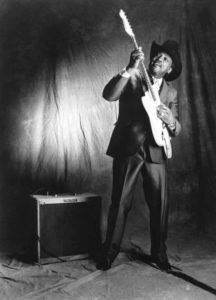I’ve known Billy Hector for more than 30 years. It began when I managed a band he was in in the early 1980s. Billy is a legendary figure in New Jersey and beyond, a bluesman without equal. He’s been entertaining audiences with his high-energy guitar playing and singing for decades and if you’re lucky you can still catch him playing three or four nights a week. Billy has his own material but he also plays blues classics and it was his torrid version of the Otis Rush song “Cut You Loose” that turned me into a Rush fan for life.
In the mid-’80s, while I was trying to make money in the music business, I still had a job in the corporate world which allowed me to make actual money. It was a pretty straight job with a major financial institution but it did have its perks. The best perk was that I got to travel to Chicago three or four times a year. Not only did I have friends living in the Windy City at the time, but the town was also still a hotbed for the style of electric blues that bore its name. Among the artists I got to see, all in small clubs, were legends like Junior Wells, Son Seals, Jimmy Johnson, and of course Otis Rush.
It was at a club called Blue Chicago at that time located on State Street on the near North Side. The club’s proximity to the downtown area made it a haven for tourists. I’m generally not fond of those kinds of places but when I learned that Otis Rush was playing there while I was in town I put that aside. I don’t remember that much about his set beyond the feeling that he was everything I hoped he would be and that was a high bar to surpass indeed.
Rush came up to Chicago from the South like many of the other artists who created the Chicago blues sound. He was born in Mississippi in 1935 and moved to the city with his family when he was 14. He made some important recordings for Cobra Records in the 1950s including the #8 R&B hit “I Can’t Quit You Baby” which was released in 1956. Other notable songs from that period included “All Your Love (I Miss Loving),” and “Double Trouble.”

When Cobra went belly up, Rush landed at Chess Records. He recorded eight sides for the label before moving on to Duke Records. His output at Duke was even lower. There was just one single for the label but that one single was “Homework.” The song was written by Rush along with Al Perkins and Dave Clark. It wasn’t a hit for Rush but it was a song that would gain new life when it was covered by the J. Geils Band on their debut album in 1970.
Rush continued recording through the 1960s on labels like Vanguard and Cotillion. His Cotillion album Mourning in the Morning was produced by the storied guitar player Mike Bloomfield along with Nick Gravenites. Both producers were members of the Electric Flag at the time. The album was recorded at FAME Studios in Muscle Shoals and appropriate to that setting the sound of the album found Rush moving in the direction of rock and soul.
In 1971, Rush recorded his classic album Right Place, Wrong Time for Capitol. For some reason, Capitol refused to release it. Five years later, Rush bought his master back from the label and had the album issued in Japan. Eventually, it was released by Bullfrog Records in the U.S. There were more recordings for labels like Sonet and Delmark in the 1970s.
Then there was a gap of 16 years between Rush albums. The drought ended when he released Ain’t Enough Comin’ In in 1994. The album won Rush his first Grammy Award. He continued to tour into the new century until a stroke brought his touring days to a halt in 2003. Although he was unable to play, Rush made an appearance at the Chicago Blues Festival in 2016 where the city’s mayor proclaimed it Otis Rush Day.
Otis Rush passed away on September 29, 2018. He had been inducted into the Blues Hall of Fame in 1984 and received a Lifetime Achievement Award from Jazz Foundation of America earlier this year.
Billy Hector has a fine new album called Some Day Baby. You can find it at iTunes and the usual online retailers or better yet if you’re in the area go to one of Billy’s gigs and pick it up there.





Comments